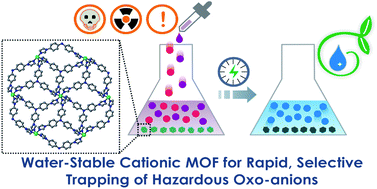Rapid, selective capture of toxic oxo-anions of Se(iv), Se(vi) and As(v) from water by an ionic metal–organic framework (iMOF)†
Abstract
Designing selective sorbent materials to sequestrate toxic oxo-anions having weaker binding tendency, for instance oxo-anions of selenium and arsenic (Se(IV)/Se(VI)/As(V)), is an arduous challenge. Herein, we demonstrate the molecular shape recognition aided synthesis of a chemically stable cationic MOF (iMOF-3C) which exhibits fast, selective removal behavior (∼99% in 5 min) towards toxic oxo-anions of Se(VI)/As(V)/Se(IV) even at ultralow concentrations (∼1000 ppb). The cationic network illustrates superior performance in the presence of interfering ions, viz. CO32− and SO42−, which was further validated by exceptional distribution coefficient values Kd > 106 mL g−1. The maximum uptake capacity stands among the best performing materials reported in the domain of ionic MOFs (iMOFs). Furthermore, iMOF-3C successfully performs in complicated systems such as river water to yield drinking quality water as per the WHO and US EPA standards. The exceptional binding ability was corroborated by DFT calculations (high binding energies) that also aid in visualizing the binding sites for the entrapped oxo-anions.



 Please wait while we load your content...
Please wait while we load your content...